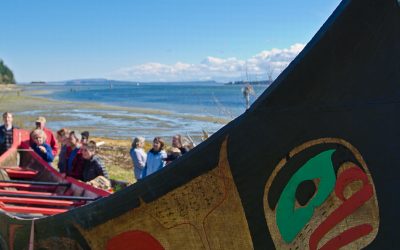The information on this page complements that which appears on the sign that has recently been erected on Sandpiper Drive near Millard Creek.
The Value of Estuaries
Estuaries are not only one of the most biologically productive types of ecosystem, they are also one of the most valuable. It is difficult to attach monetary worth to these ecosystem services, especially since most are needed for life on earth and are not replaceable with human-made systems, at any cost.
Macdonald Wood Park
The Macdonald Wood Park Society was formed in 1994 when this natural area was threatened by a potential development. This valuable habitat contains one of the last intact midden on the coast and is a sensitive ecosystem encompassing a scarce salt marsh.
Ancient Fish Traps
A large scale, technologically sophisticated intertidal fishery in Courtenay, British Columbia. The information on this page comes from Comox Valley Archaeologists Nancy Greene and David McGee. While it is not a Project Watershed project, we proudly support this body of work.
Arden Keeps it Living at the Airpark
[av_two_fifth first min_height='' vertical_alignment='' space='' custom_margin='' margin='0px' padding='0px' border='' border_color='' radius='0px' background_color='' src='' background_position='top left' background_repeat='no-repeat' animation='' mobile_display='']...
The K'ómoks Estuary Speaks
A First Nation’s perspective of the estuary and our relation to it.
This film debuted in April 2016 at the Courtenay Museum as part of the Pieces of an Estuary presentation. Pieces of an Estuary was an environmental art and public education project of the Emily Carr University of Art + Design in consultation with the David Suzuki Foundation and in partnership with Project Watershed. The project was offered as a combined studio and humanities course at North Island College in the Spring of 2016, as part of the collaborative BFA program with Emily Carr University of Art + Design.
Many thanks to the Denise, Heather, Jenna and Tonja for their work in creating this film.
What is an Estuary?
What is an estuary? This film explores this from the bottom of the ocean to the top of the glacier.
Streamkeepers Training Workshop
Project Watershed is hosting a Streamkeepers Training workshop this September for $50.
Groundbreaking Archeology Celebrated!
Nancy Greene and David McGee, local archeologists and Comox Valley residents, are going to be speaking at the upcoming K'ómoks Estuary Seafood Dinner. Their groundbreaking research The Comox Harbour Fish Trap Complex: A Large-Scale, Technologically Sophisticated...
Stephen Hume: Archeology student publishes paper on ancient, industrial-scale First Nations fishery
England’s monarchs were sacrificing to Woden and persecuting Christian missionaries when First Nations managed a vast, highly-productive, industrial-scale fish harvesting complex in the estuary of the Courtenay River.
At first, the elaborate arrangement of 300 ingenious traps on the sandy flats of the river mouth harvested herring, which still mass to spawn off the east coast of Vancouver Island every March.
But 700 years ago, perhaps in response to climate change, the technology was altered to exploit pink, chum, coho, chinook and possibly sockeye salmon.
Upcoming Streamkeepers Course
Streamkeepers is a fun and educational 2½ day introduction to stream stewardship which will be taught by Michele Jones.
The K’ómoks Estuary- A cultural & archaeological treasure
This video was produced and prepared through the Comox Valley National Historic Site Committee, as a descriptive information piece to go along with the submission to the National Historic Sites and Monuments Board of Canada to respect, honor and give Historic Site recognition to the Ancient Wood Stake Fish Trap System studied by Community Archaeologist Nancy Greene and Geologist David McGee in the K’ómoks Estuary.









